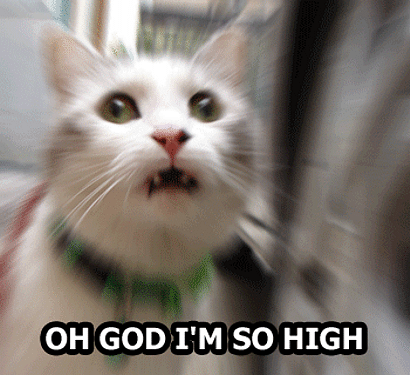Funny Gifs Biography
Source(google.com.pk)
In the "Critique of Aesthetic Judgement", Kant attempts to separate disinterested aesthetic contemplation from interested judgements of bodily appetite (1911:90). He privileges aesthetic contemplation over judgements of pure and sensual pleasure. However, his critic, Bourdieu, argues that that the pure, contemplative gaze to which Kant refers and defends, is no more than an experience of class-mastery of a cultural ability to interpret formal aspects of a representation and position it within a predetermined cultural context (1984:6). In other words, when one engages in aesthetic contemplation, one merely recognises and confirms cultural power. Bourdieu's aim is to abolish the "sacred frontier" which sets apart legitimate public culture from ordinary tastes and preferences in art and other areas such as fashion, music and sport. He seeks to break down and expose the containing frontiers of high culture and show how power is utilised through cultural consumption. In doing so, he attempts to invert the value relations within the Kantian system. He argues that high culture is only rendered legitimate through its focus on sublimated, disinterested pleasure and its identification of lower, vulgar or venal enjoyment as illegitimate. High culture confers legitimacy on the objects within its domain, precisely through its repudiation of bodily pleasures. In other words, cultural legitimacy involves constraining and structuring the effect of the object or image on the viewer. Cultural distinctions then are made on the basis of the separation of the pure gaze of the connoisseur from the motivated, interested gaze of the cultural vandal. Implicit in Bourdieu's thesis, is the notion that there is no objective basis for determining cultural suitability. In regards to art, cultural distinctions are made through the production of norms of behaviour and expectations concerning the nature of the art object. Those who are in positions of power determine what the suitable responses to art should be. Illicit art is best understood in terms of its deviation from these norms of cultural appropriation. Culturally acceptable art is directed towards contemplation and reflection; illegitimate art or non-art is that which deviates from these cultural anticipations.
III
In the 1970's and 1980's, an art movement known as performance art, emerged (Carlson 1996). Still pursued today, performance art is directed towards expressive qualities of the body and is particularly opposed to logical and discursive thought and speech; it seeks to privilege process and disregard content and product. Although some aesthetic connoisseurs are willing to accept this form of artistic expression as legitimate, there are many contexts in which this style of artistic presentation is considered to be outside the realm of the aesthetic. Some performances are viewed as clearly off-limits, non-art, bodily and obscene. "Post Porn Modernism", a contemporary performance piece by Annie Sprinkle, is considered by many art-world connoisseurs to be gimmicky, pornographic, inferior and therefore non-art (Scneider 1997: 53). During her confronting performance, Sprinkle invites her viewers to gaze at her cervix with a flashlight through a speculum she inserts into her vagina. Sprinkle's performance crystallises the aspects of lower, vulgar, bodily artistic expression, which is so heavily repudiated by the historical ethos of high art culture. But now, what grounds are there for rejecting her performance as aesthetically illegitimate? Is the performance to be condemned on the basis that it privileges bodily expression, unrestraint and autonomy over reflection and contemplation? We have seen from Bourdieu's thesis of cultural distinctions that there are no objective cultural reasons for condemning a piece of art on the basis of its bodily, pleasure-oriented interests. Sprinkle's art invites criticism due to its illicit nature; it is art which involves pleasure of the senses; it is sensually immediate; it pushes the viewer towards under-distancing; it deviates from what those in positions of aesthetic power identify as culturally valuable. However, there are no objective grounds for condemning Sprinkle's performance on the basis that it is bodily and directed towards pleasurable bodily response. Certainly, her performance is sexy, alluring, pushes ones towards under-distancing. However, we have seen that these qualities of an object of art are only illegitimate, not worthy of artistic praise in the context of opposing qualities being privileged. Only if aesthetic contemplation, proper distancing and reflection are critical aspects of objects of art, are sexiness, raw pleasure and bodily response disturbing and illegitimate components of them.
We can make use of Sprinkle's performance pieces by investigating what, if any, artistic worth or condemnation can be ascribed to striptease. The common view of striptease appears to suggest that it is pornographic, its main aim is to arouse, titillate and therefore is outside the realm of the aesthetic. However, strippers identify themselves as performance artists, they consider the process of stripping to be artistic and any one strip is for them an artistic performance. Is stripping a legitimate form of artistic expression? Or does striptease reside outside the sphere of aesthetic appreciation and consumption? If it is allowed that Sprinkle's performance pieces are legitimate artistic expressions, despite their bodily, sensuous appeal, then it seems that there may be grounds for defending the view that stripping is a form of art, not merely a type of pornography. Certainly, it seems that the stripper's performance should not be considered non-art, merely on the basis of its attention to sexual arousal and eroticism. If stripping is non-art, then something more than a process of cultural distinction, and the possession of power, is required to show that it is not art. If stripping holds no artistic value and deserves aesthetic condemnation, something more than the usual appropriation of cultural values is needed to show that this is the case. But now, one might allow that stripping is a legitimate form of artistic expression, however one may also hold that it is not good art. Perhaps one might hold that striptease lacks many of the necessary and sufficient conditions required of a piece of art to warrant viewing it as good art. However, here it must be acknowledged that this type of concern can be lodged against any type of art. If this particular worry has relevance to all objects of art, then the concern is of a global nature. It is not specific to stripping and hence is of no assistance whatsoever to the aesthete who isolates stripping from other forms of artistic expression and condemns all of its instances on the basis of their lack of artistic merit. If the notion of necessary and sufficient conditions were allowed, then each striptease would need to be carefully considered and appraised in relation to these necessary and sufficient conditions. It would not do to suggest that striptease, generally, is bad art. This is as plausible as suggesting that oil on canvas in bad art. In addition to this, it seems that the necessary and sufficient conditions which have been alluded to here and which determine whether an object warrants artistic applaud, are culturally determined. These rules and restrictions are governed and implemented by those in positions of power who, by their denial of "other" necessary and sufficient conditions, distinguish between good and bad art. Once again, there are no objective, culturally removed, criteria for determining whether an object of art is good or bad.
Funny Gifs
Funny Gifs
Funny Gifs
Funny Gifs
Funny Gifs
Funny Gifs
Funny Gifs
Funny Gifs
Funny Gifs
Funny Gifs
Funny Gifs












.gif)


